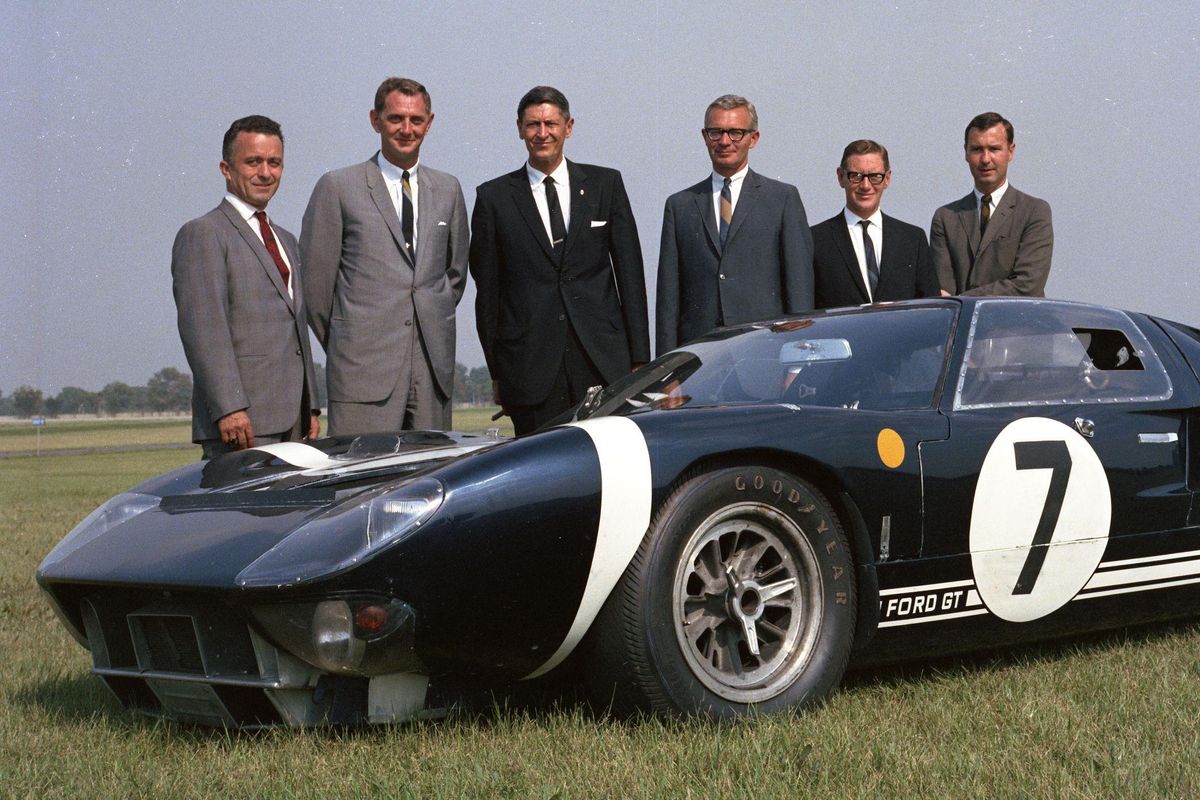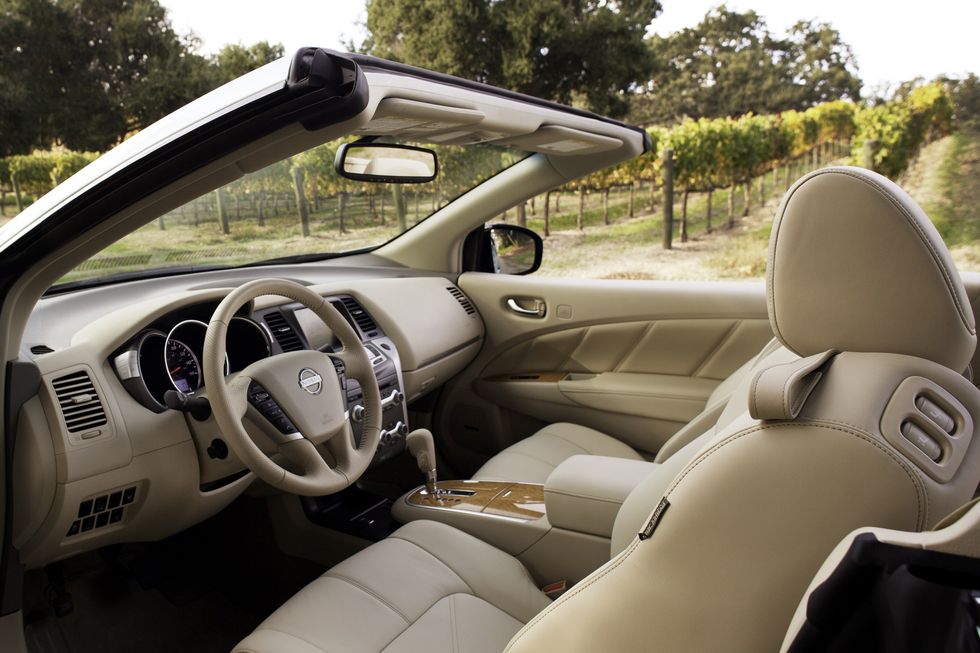
Buy
Resources
Entertainment
Magazine
Community
In This Article
Category:
Car Culture
With the release of the Ford v Ferrari movie, there has been renewed interest associated with my 2016 article here on Hemmings concerning Ford executive Leo Beebe and the end of the 1966 Le Mans race. Comments, around 200 in number four years after initial publication, show the passion of people on both sides of the dispute. With that in mind, it's worth another dive into what kind of person Leo Beebe was, based on his background and people who knew him.
Editor's note: This story comes to us from Hemmings reader and contributor Frank Comstock, a friend of the late Leo Beebe.
Let’s think of this as a highway between two cities representing the two major aspects of the dispute. While there are several entrance and exit ramps along the highway, the ramps at one city represent the argument that Beebe did not like Ken Miles and didn’t want him to win the race, while the ramps at the other city represent the argument that Beebe engineered the end of the race to please Henry Ford II, the man who had funded Ford’s Le Mans effort to the tune of as much as thirty million dollars. The ramps in between those cities represent the opinions of those who fall somewhere in the middle of the two sentiments.
Readers who did not like the outcome of the race said Beebe was arrogant, stuck-up, interested only in himself and in furthering his own career, egotistical, narcissistic, petty, evil, and a corporate thug who should have been fired. Hemmings readers who knew Beebe after his time at Ford have scratched their heads because the man as shown in the movie is not the man they knew.
A comment from one reader struck a nerve and drove me to try to understand his point. The reader said, “My great-grandfather was employed at Ford during this time and repeatedly cussed both HFII and Beebe… he cussed him because Beebe was full of himself and he looked down on everyone that was not of his stature, especially us country folk.”
That comment made several people who knew Leo Beebe, including myself, shake our heads in wonderment because that did not describe the Leo we knew. The reader reported it, so we certainly believe his relative said those words. We just wonder why the man we all knew after his time at Ford was so different. I’ve attempted to find people who were at Ford when Leo was there, without any success. The 1966 race at Le Mans was 54 years ago, and Leo retired from Ford in 1972, 48 years ago. Even the youngest of Beebe's coworkers at Ford would have to be at least in their late seventies or older. I encourage anyone with knowledge of Beebe or HFII at the time to come forward. I have an open mind and I would love to hear your stories.
Who was Leo Beebe?

Still another Hemmings reader, after checking out all the comments, noted the disparity in the comments and made this suggestion: “Perhaps in just a few words you can tell us your opinion of Leo’s personality and his nature as a gentleman.” Asking a writer to use a few words will probably never work. We’re not wired that way, but your suggestion is valid, and I’ll address that request in a bit more than a few words. Before focusing on the disparities in descriptions of this man, let’s start with a short biographical sketch.
Leo Beebe was born to a farm family in Antrim County, Michigan, in July 1917. His father apparently wasn’t a very good farmer because the 1920 census shows the family in the village of Elk Rapids, where his father was then listed as a laborer. Sometime after 1920, the family moved to Dearborn. Leo often said he grew up in the shadow of Ford’s iconic River Rouge plant. The family lived on Appoline Street, about two miles by road from the Rouge. We know the elder Beebe worked as a conductor for the Detroit trolley system from around 1930 through 1947. After that, Leo’s father worked as a janitor for the Edison Institute for a couple of years and by 1953 he was working as a janitor at Ford while his son was a rising executive.
Beebe went through the local schools, including Fordson High School, where his performance in both academics and sports earned him scholarships to the University of Michigan. At least one of Leo’s college summers was spent working on the factory floor at the Rouge, alongside a young Henry Ford II. He worked throughout his college years, both in the summers and during the semesters, for extra money. Leo did not come from wealth, was raised in a working-class neighborhood and clearly was born to a rural, farming family. He returned to Dearborn after college and lived there until the middle 1960s (in a different middle-class neighborhood than his childhood) even as other Ford executives moved out to fancier zip codes.
After lettering in baseball and basketball at the University of Michigan and graduating in 1939, Leo began teaching and coaching sports at several small-town Michigan high schools, including his alma mater, Fordson High School. At the same time, he played basketball and baseball wherever he could. Eventually, he discovered the AAA motor club had a semi-pro baseball league for employees. The only job he could get with AAA was selling car insurance, at a time when the liability portion of car insurance was not mandatory in Michigan. Wanting to play baseball, he took the job and in his first month outsold every other salesman in the organization.
Beebe enlisted in the Navy in a program that gave men advanced rank for civilian experience. He entered as a petty officer in the Navy’s physical fitness program and was sent to one of the Navy’s schools then being conducted at the Rouge plant. His commanding officer just happened to be Henry Ford II, assigned to the plant probably because of his name. HFII was impressed with Leo’s performance at the school and told him to come see him after the war – Ford would definitely find something for him to do.
What did Leo Beebe do at Ford?

Leo Beebe's public service included assignments under Presidents Dwight Eisenhower and Lyndon Johnson. Above, in 1969, Johnson and Beebe (standing, right) at a meeting of the National Alliance of Businessmen.
Photo from the Leo C. Beebe archives.
Having been commissioned as an officer during the war, Beebe returned to Ford after the conflict and immediately established a physical fitness and sports program for the company. Before retirement in 1972, he would have almost 30 titles at Ford, including positions in public relations, advertising, and marketing in the first few years. He began making a name for himself, especially in marketing, and became an expert in using film to tell stories to customers and employees, eventually working into leadership roles in the burgeoning field of industrial moviemaking.
By the late 1940s, Beebe was in demand in the Detroit area as a motivational speaker for civic, school, religious, and sports organizations, activities he would keep up throughout his life. He was a lifelong Rotarian, a member of several school boards, active in United Way, a founding member of Reading Is Fundamental, and a prominent member of several business organizations. Leo was a man of deep faith and a leader in the Episcopal church. To this day, copies of sermons he presented at various churches exist in his collected papers.
In 1956, the Eisenhower administration came to Ford looking for an executive to manage the resettlement of refugees after the Hungarian Revolution. HFII sent Beebe to Camp Kilmer in New Jersey to lead a team of businessmen, State Department, and Defense Department personnel in the eventual resettlement of almost 36,000 Hungarians.
HFII detailed Beebe to the Edsel Division in 1958 for what he promised would be a two-month assignment to help with marketing the Edsel models. Two months turned into 18 months, as Leo reworked the marketing and eventually was part of the team to shut down the division.
From Edsel, Beebe was sent to Florida in 1960 when President Eisenhower asked for help in resettling Cuban refugees. He continued working with the Kennedy administration in 1961. Leo said little of this assignment to anyone, so we have scant information about that time. Returning to Ford, Leo took several positions in the Ford car and truck divisions, before moving to Switzerland to lead Ford of Europe. He was there when Lee Iacocca and HFII called him to take over Special Vehicles with the task of making the race teams a winning operation. After Le Mans, Leo became Vice-President at Lincoln Mercury, eventually dabbling in a small way again in racing with the sports car program for the Mercury Cougar.
While running Ford of Canada, he was again called to presidential service when Lyndon Johnson named him to lead the National Alliance of Businessmen as Johnson addressed the crushing unemployment among minority workers in the United States. Leo’s last assignment with Ford was in Philadelphia as the Vice-President of Philco-Ford.
When did Leo Beebe leave Ford?
Retiring in 1972, Leo began consulting for a number of corporate and government organizations and took a job teaching marketing at the then-new school of business at Glassboro State College in Glassboro, New Jersey (now known as the Rohrer College of Business at Rowan University). His skills as a leader were immediately apparent and he became the dean of the business school for several years, until someone with a true academic, educational background could be found. Teaching marketing for almost thirty years while consulting around the world, Beebe took on the CEO position at K-Tron International as an additional role. Leo was also well-known for sitting at a table in various southern New Jersey restaurants with a glass of iced tea while he gave lunchtime, masters-level seminars in operating businesses to young entrepreneurs – all at no cost.
How accurate is Leo Beebe's portrayal in Ford v. Ferrari?

A pit stop at the 1966 24 Hours of Le Mans. Beebe is standing behind the pit wall.
Photo courtesy of Ford
Given all of this, you might see why those of us who knew Leo after his time at Ford are puzzled by the portrayal in the movie and the opinions voiced in the comments. The man we knew was soft-spoken (usually), humble, a team player, a man of faith, and a leader who inspired others to greater things. Was he arrogant or, at least, was he arrogant while at Ford? Until someone who knew him at Ford comes along to tell the story, those of us who knew him later have to believe he wasn’t arrogant then because he certainly wasn’t arrogant in our presence.
The man I knew and worked with on occasion in the middle 1970s was conservative in dress and deportment and correct (as we might have said then) in his relationships with others. Brilliant? Yes, without a doubt. Self-assured? Yes, based on a lifetime of success. Could these characteristics come across as arrogant? I suppose some might have thought that. There were certainly students who were awed by him, and maybe a little scared of him, but Beebe was actually a man who would share everything he had learned in life with anyone.
Leo had started as a child of a poor farm family and grew into a man whose office was just doors away from HFII in the Glasshouse at Ford’s headquarters. His early life involved taking extra jobs to have enough money for school, while in later life he enjoyed the fruits of his labor. Able even in retirement to have any new Ford, Lincoln, or Mercury car every year, he chose Mustangs or Cougars after 1964, at least through the time I knew him. He just liked the cars and didn’t want anything fancier. Beebe spent his life working with highly placed men and women and was as comfortable in the Oval Office with several different Presidents as he was eating hamburgers and French fries with me at a Hardee’s hamburger restaurant on several Tuesday nights as we discussed some of the things he had done at Ford.
Was he egotistical, a narcissist, petty, and evil? I never saw any of that. I will admit that he could come off as a little stiff and formal, which might have been interpreted as arrogance by some. Should he have been fired? I spent a good portion of my working life in Human Resources and I can assure you I never saw anyone fired for doing what they were told to do.
Did Leo Beebe take credit for others' hard work?

Fran Hernandez (Right) watches the Trans-Am Cougars along with Leo Beebe (left) and Bud Moore.
Photo from the Fran Hernandez archives.
Edward Cloues, currently the Vice-Chairman of Virtua Health, worked with Leo at K-Tron, got to know him well, and describes Leo as “a humble person… arrogant and stuck-up would be foreign concepts to me as a way to describe Leo. He was precisely the opposite. Others always came first. Leo wanted the team to succeed and get the credit, but Leo was quick to step up and shoulder the blame if need be. Leo listened to everyone’s opinion and took no credit for himself.” Emphasizing Beebe’s deep faith, Cloues said, “He was a true servant leader. He told me he would get more credit than he deserved even if he did nothing to bring credit on himself.”
Kathy Eddleman worked with Leo for more than thirty years both at the university and at K-Tron. She says, “I never found Leo to be arrogant or stuck up. [I was] frequently at lunch with him and others where ‘rank’ or position did not matter. Once I was flying to a meeting in England with him and while I was flying tourist, he was flying business. This embarrassed him and he offered to swap seats halfway through the flight.” Addressing teamwork, Eddleman says “I worked closely with Leo on many conferences and projects at K-Tron. He would always go out of his way to congratulate me for the success of the project, both in writing and in person. If he had a different opinion, he would listen and often concede or compromise. Having Leo as a mentor was one of the highlights of my professional life.”
Dr. Robert Lynch, professor emeritus at Rowan University and long-time friend of Leo said, “His combination of many talents, strict values, interpersonal skills and humble characteristics was unique. He believed that the perfect formula for successful living is that if you want to be first, you must be the last of all and servant of all.” Last of all and servant of all was a phrase often heard in Leo’s own voice.
Ford CEO Philip Caldwell once said of Leo, “You could not work for Ford Motor Company not knowing a lot about Leo Beebe. He had quite a reputation. He was a man of all seasons.” In a 1960 speech (during his Ford time and before Le Mans) to a Rotary club, Leo said, “You cannot succeed without putting regard for others on a par with regard for yourself.” That is not the statement of an arrogant man. An acronym that frequently creeped into Leo’s thoughts, writings, classroom lectures, and speeches was DWYSYWD. It meant “Do What You Say You Will Do”, meaning of course that if you say you will do something, you must carry through.
Was Leo Beebe a good leader?

Bruce McLaren, Henry Ford II, and Chris Amon on the victory rostrum at 24 Hours of Le Mans 1966.
Photo courtesy of Ford
This story can’t end without talking about one of Leo’s reputations for bringing order out of chaos. Leo Levine, author of "Ford: The Dust and the Glory," told the story of Beebe attending a meeting of the Ford racing staff where he listened to everyone and then said, “I don’t know anything about racing, but it’s obvious none of you do, either.” I had already read Levine’s book when I was working with Leo occasionally at the university, although I had never heard him say that. I asked him if the story was true one night as we had hamburgers at Hardee’s. He laughed and said it was.
At a meeting a few days later of some team we were both on, Leo was one of the last people to enter the room and he sat next to me at the round table. As the leader, he gave everyone a chance to speak. I don’t remember the subject of the meeting, but Leo said, “I don’t know anything about this, but it’s obvious that none of you do, either.” After listing off all the things the team needed to do, Leo turned to me and said he really did use that trick when he needed to focus a team that failed to understand the mission. Was that arrogant? Maybe it was seen as such by some, but it truly was just his way of focusing a team.
One example of Beebe’s habit of stepping back when a team achieved success can be taken from Le Mans, the very subject that engenders all the negative comments. I have never found a picture of Leo in victory lane with the drivers. HFII was there, of course, but if Leo was ever in victory lane, the picture must be well buried. There is an obscure picture of him a few nights later in a French restaurant celebrating with Amon and McLaren and others. If Leo Beebe was truly arrogant, egotistical, narcissistic, petty, and evil, he would have been front and center in the victory lane photos. The victory was the result of the team’s efforts and an unlimited checkbook from Henry Ford. Leo let the team and Henry Ford celebrate in victory lane. That was the kind of man he was.
Why did Leo Beebe orchestrate the end of the 1966 Le Mans race?

The infamous staged finish to the 1966 race.
Finally, let’s address again the question of who organized the end of the 1966 Le Mans race. As I wrote in 2016, Leo “…never wavered from the published reports on who was responsible for the controversial finish at Le Mans in 1966—it was his responsibility as team leader, and he made the decision that he thought was right at the time.” I also said, “I pushed hard to see if Henry Ford II had influenced the race-ending decision, but Leo wouldn’t answer that question. He just pulled out the note from HFII he still carried in his wallet. It was so simple: ‘You better win.’"
Both Leo, who died on June 30, 2001, and HFII took the truth to their graves. It is my opinion that HFII was involved in the decision and may have made the decision, but lacking factual knowledge of that, it is just my opinion and I can’t report it as truth. As someone who is also a novelist, I know that stories, whether in print or on the screen, should have both antagonists and protagonists. In Ford v Ferrari, Leo Beebe was cast as the antagonist. For those of us who knew him, it’s a shame because that’s not the man he was in real life.
Recent
What makes a future classic? While we often focus on the potential financial upside of the hobby, or at the very least not losing your shirt because you bought a car, not every classic is destined to make a mint. Some cars will just be fun and possibly the center of attention at a car meet down the road rather than an investment. We think that’s exactly the case with our latest choice for a future classic: the 2011-2014 Nissan Murano CrossCabriolet.
Quite possibly the answer to a question nobody asked, the Murano CrossCabriolet combined a family-sized, two-row crossover utility vehicle with a convertible. More accurately, Nissan’s designers and engineers extensively reworked the five-passenger, five-door unibody Murano to turn it into the two-door CrossCabriolet version.

CrossCabriolet Genesis
The story has it that Carlos Ghosn, then head of both Nissan and Renault, thought that the U.S. market needed a crossover convertible. More specifically, Nissan’s product and marketing folks targeted boomers and women with the car that brought high ground clearance and open-air motoring into a 21st century automobile market focused on car-based utility vehicles. About the closest thing on the road was the more utilitarian Jeep Wrangler, which served a very different audience and purpose. Go back a few decades and the coachbuilt AMC Sundancer models provide a glimpse into the same sort of thinking that inspired the CrossCabriolet.
Mocked when it was new for being weird, the droptop still gains attention for being unlike anything else on the road. Sales were low, but not dreadful, with an estimated 6,000 or so examples sold from 2011 through 2014. Considering that the CrossCabriolet’s sticker price of around $45,000 was a solid 50% greater than a base Murano, Nissan might as well have been courting Infiniti buyers. Like so many weird, seemingly unloved cars, attention for these unique convertibles picked up the moment they went out of production. A 2018 article in Automotive News highlighted that 2014 CrossCabriolet models were in demand, and shared data indicating that they were selling at two-thirds of their original price, while the average 2014 car was selling at just 43% of its original MSRP.

The CrossCabriolet was based on Nissan's Murano, a conventional, five-door, two-row midsize crossover utility vehicle.
Nissan's Midsize Crossover
Since it shares so much with the Murano CUV, here’s some brief history of the original. Nissan introduced the American-designed Murano for the 2003 model year. Based on the same platform that underpinned the Altima, Maxima and even the Quest minivan, the Murano arrived right on time to a market falling in love with mid-sized “soft-roaders”—car-based utility vehicles with a bit of extra ride height and optional all-wheel drive, to better handle inclement weather or gravel roads rather than trails of any significance.
For the U.S. market, the Murano has only been available with a version of Nissan’s near-ubiquitous VQ V6 engine, a powerplant used in sedans, coupes, minivans, SUVs, CUVs, pickup trucks, sports cars, luxury vehicles and probably some other model types we’ve forgotten about. Front-wheel drive was standard on base models, with all-wheel drive optional, though on higher trim levels it was standard. All were equipped with a continuously variable transmission rather than a conventional automatic. As with many modern passenger vehicles, a host of comfort and convenience options were available. As is typical for many Japanese automakers, most of these options were included wholesale with each trim level. For instance, if you wanted heated seats, you had to opt for the same trim level that included power-operated and leather-upholstered seats.
Along with four-wheel disc brakes and four-wheel independent suspension, a long list of safety features were standard on the Murano, including electronic stability control, antilock brakes, and a host of airbags. Of course, modern requisite safety items like three-point seatbelts for every passenger, an energy-absorbing steering column and LATCH connectors for child seats in the rear were also included.

All Murano CrossCabriolet models were built in the top-spec trim level, which included powered leather seats with memory as standard equipment.
Changes Made to Make the CrossCabriolet
When the CrossCabriolet model was introduced for 2011, the Murano was two years into its second generation. Little had changed with the formula or even the size of the model as the wheelbase remained the same. Likewise, the drivetrain was still centered on Nissan’s proven VQ engine backed by a CVT. That 3.5-liter V6 got a boost in power with the 2009 redo and was rated at 260 horsepower in 2011.

The hard rear tonneau cover handily concealed the Murano CrossCabriolet's fabric top when down.
Body-wise, the front clip was straight off the standard car, but everything from there back was all new for the CrossCabriolet. Most notably, in lieu of the regular model’s four doors, the convertible was a two-door only affair, with each door 7.9 inches longer than the front doors of the base Murano. The removal of the roof necessitated plenty of changes to the structure, which Nissan reported was “reinforced from the A-pillar rearward.” In lieu of a “basket handle” roll bar for body stiffness (think: 1990s front-drive Oldsmobile Cutlass Supreme convertible or Volkswagen Rabbit Cabriolet), Nissan engineered a pair of pop-up roll bars to deploy automatically behind the rear seat headrests at a high rate of speed when the vehicle’s sensors detect an imminent rollover.
The convertible top was fully insulated, helping the all-wheel-drive CrossCabriolet achieve true four-season use. The top could be lowered via switches on either the center console or the driver’s door handle. With a hydraulic folding mechanism and automatic latches, it was truly a one-button process. Though the primary rear window is glass, there is a wider secondary window, made of thinner plastic, just ahead of the glass windows. This additional window is there for the pop-up roll bar to punch through in the event it is deployed in an accident. Apparently, the insulated roof and its folding structure hamper the force of the roll bar in action.

The front section of the CrossCabriolet was shared entirely with the standard Murano, but all of the body panels behind it was unique to the convertible.
Well-Equipped Convertible
With an MSRP that ranged from $47,000 to $42,000 (the price actually went down during its four-year run), the CrossCabriolet was only available in the highest trim level and only with all-wheel drive. Standard equipment included the usual contingent of luxury features, such as leather upholstery, heated seats and steering wheel, 20-inch aluminum-alloy wheels, HID headlamps, a Bose audio system, and a full slate of powered accessories, including not just the windows and locks, but also the seats, steering wheel and outside mirrors, all with position memory. About the only option was a navigation package that included a touchscreen and Bluetooth connectivity.
The droptop Murano was able to deliver excellent space for its rear seat passengers, an uncommon trait with most convertibles. Its higher ride height offered a unique vista for all occupants, as opposed to the typically low-slung sports car convertible. Performance was a bit sluggish compared to the standard Murano which was a few hundred pounds lighter, but the Nissan V6 still did a decent job of allowing it to keep up with traffic. Storage space compared to a conventional CUV was a notable drawback, but let’s not forget the one thing that makes the CrossCabriolet special: It was made for fun. And it’s hard to point fingers at a modern automaker that decides to make a car that’s supposed to be fun and enjoyed for itself, rather than to just haul people and cargo.

But, really, is a convertible SUV all that unusual? Jeep had had no problem selling them since they invented the civilian SUV in the 1940s. Ford has had various vehicle platforms with the Bronco name and a removable roof on and off since the 1960s. Land Rover and Toyota are two automakers that did well for themselves with convertible, go-anywhere vehicles. Not long after the Murano CrossCabriolet went out of production, Range Rover introduced the Evoque Convertible. With a front, transverse-mounted engine along with a front-biased all-wheel-drive system, the Evoque had more in common with the concept of the Murano than it did a traditional Land Rover.
As indicated above, we don’t expect the Murano CrossCabriolet to set the charts on fire with significant price movements, but we do expect the car to become coveted by collectors, particularly those enamored not with performance or luxury models, but the weird and unusual, which absolutely have a place in this hobby. It might still be too modern for some shows, but this uncommon crossover will surely be a conversation starter for any collector who acquires one.
Keep reading...Show Less
Netflix
Netflix just shared its first trailer video to tease its latest up-and-coming racing action series titled “Senna,” in which Brazilian actor and musician Gabriel Leone plays the title role of Ayrton Senna da Silva, a Brazilian racing driver who won the Formula One World Drivers' Championship in 1988, 1990, and 1991.
The six-episode series, produced by filmmaker Vicente Amorim and directed by Julia Rezende, will give audiences a look into the early life of Ayrton Senna, one of Formula 1’s greatest drivers in history, while also portraying a handful of other F1 drivers from the era such as Niki Lauda and Alain Prost. According to Netflix, the series, which begins in the early days of Ayrton's motorsport career when he moves to England to compete in the Ford Formula, will follow Senna into stardom, concluding with the tragic accident in Imola, Italy, during the San Marino Grand Prix.
Senna, which is produced with support from the driver's family, is filmed in real-world locations including São Paulo and Rio de Janeiro, though the action-packed trailer mostly sticks to close-cropped framing with the focus on Leone playing Senna racing behind the wheel of an F1 car.
"It is a huge responsibility and also a great honor to be able to represent an icon who inspired so many people throughout his life, showing the world Brazilian sporting talent," says Leone. "Knowing that we will bring this story to millions of people in so many countries, through Netflix, inspires me to see this as one of the great roles of my career."
Senna | Official Teaser | Netflixyoutu.be
Keep reading...Show Less





